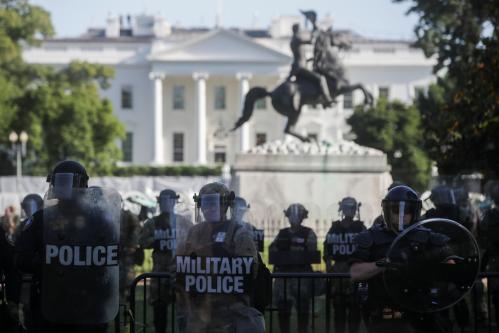Last week, the State Department went public on a $500 million grant to assist Mexico combat growing insecurity. It is hoped that similar monies will be appropriated in the next two fiscal years to achieve a total of $1.4 billion for Mexico and Central America. Given the size of the grant—a ten time heft over last year’s security and counter-narcotics appropriation to Mexico of $45 million—we need to examine the key ingredients, the rationale and the implications for distributing these U.S funds.
For the past six months, without input from respective legislatures, government officials have quietly planned this joint endeavor. The newly elected president of Mexico, Felipe Calderon, campaigned on a platform of citizen’s security, committed $3 billion of federal funds to this priority and persuaded the Mexican army and navy to lead the fight against the drug cartels and the criminal networks. The cartels and the networks are distinct, but drug money is the juice that feeds both enterprises: together, they have become an international threat to Mexican national security. In this campaign, President Calderon found a strong ally in President Bush. In March this year, they met in the colonial town of Merida to strategize on combating transnational crime. In the interim, and out of public scrutiny, government officials drew up the technical elements of a plan, known as the Merida Initiative, to avoid any confusion with Plan Colombia.
Under the terms of this Initiative, the United States will commit 41% of the $500 million grant to military equipment, which will include six brand new Bell 412 helicopters and two Casa 245 twin-engine aircraft. Accompanying both is a two year agreement to provide maintenance and spare parts. This represents a significant improvement over the gift of Hueys in the 1990s under the Excess Defense Articles program. Those helicopters soon became inoperable and were cannibalized for spare parts, leaving a bitter taste by the recipients of “hand me downs.” Now, the grant of new equipment, plus the maintenance and spare parts, assures the Mexican armed forces that we take collaboration seriously. However, the planned use of the Casa aircraft needs to be discussed publicly, given its multiple and potential capabilities from medevac to cargo, to intelligence gathering, even to use as a gunship equipped with light cannons.
There is encouraging news in the Initiative that 59% of the grant will be earmarked for civilian agencies responsible for law enforcement. This is much needed, but the number and complexity of Mexico’s security agencies will need more than cash to reform. Multiple Federal agencies have earned a reputation for ineffectiveness and corruption; among them, the Attorney General’s Federal Investigative Agency, the Ministry of Public Security’s Federal Preventive Police Force, the Ministry of Government’s Center for Investigation and National Security and the Ministry of Finance’s Customs Administration. Furthermore, the 32 states within the Mexican Federation hold responsibility for crime control. State security agencies and the courts have not protected the citizenry effectively. According to surveys carried out by Transparencia Mexicana, the police and justice system are perceived as having worse problems of corruption and inefficiency than other public agencies.
In the immediate term, Calderon has called upon the Mexican armed forces to lead the fight against organized crime. They hold a national reputation for honor, ranking near the top in Mexican public opinion polls, while the police and justice agencies rank near the bottom. Both the army and navy have strong operational capacity, but they are now being asked to undertake anti-crime tasks that they have not been trained for. To meet this need, Calderon has created a new National Federal Police Force, with a management structure to ensure operational effectiveness, as well as respect for human rights. While this new police force is being trained, the Mexican armed forces will play a key role. How long this will take should be an issue of public debate.
What has occurred on our southern border to require radical reform of Mexico’s security and judicial institutions? Over the last year, criminal violence in the northern states of Mexico has increased by six times. Although the overall homicide rate has fallen over the past twelve years for Mexico as a whole, the rate of violent murders in the five northern states of Nuevo Leon, Sinaloa, Chihuahua, Durango and Baja California has increased from 306 in the period January to October 11, 2006 to 2,113 for the same period in 2007. Two police chiefs have been murdered, six journalists covering the Zeta cartel have been gunned down and two more “disappeared.” Ordinary Mexicans in these northern states believe that their daily lives are threatened and have called upon their government to respond firmly.
Neither the cartels nor the criminal gangs respect the U.S. border. Evidence is growing that the Mexican criminal world seeks to corrupt U.S. officials. Also, kidnappers from Baja California have crossed into San Diego County to seize Mexican citizens who had moved their families north to escape insecurity. We have two choices, join with our neighbors or wait and unilaterally try to contain them within the United States. Until recently, U.S. security agencies had viewed with suspicion any joint action by Mexican authorities. Now, this has changed. Whether Calderon inspired trust, or demonstrated the extent of criminal penetration into a weakened state that threatened Mexico’s democratic govern ability, the U.S. government assumed the challenge seriously.
The details of this plan must now be shared with the Mexican and U.S. Congress to ensure transparency in the formulation and implementation of the Merida Initiative. The grant of military equipment and short-term measures to contain criminal networks may de-capitate their leadership and create internal confusion for a while, but the underlying political and socio-economic reasons for their criminal enterprise will oblige them to re-emerge. Both our societies need to understand what lies behind this upward catapult in criminal behavior and both Mexicans and North Americans need to understand what is at stake. Threats to security impact daily lives, economic activity, as well as the diversion of resources from education, health and housing to police and military operations. Comprehension of the interrelated nature of security threats requires openness with the public, a willingness to test assumptions and dialogue over priorities. To engage both our societies is to raise awareness and seek public support for a sustained offensive that may have to continue for a decade.



Commentary
Op-edThe Merida Initiative: Time for a Healthy Public Debate
November 6, 2007